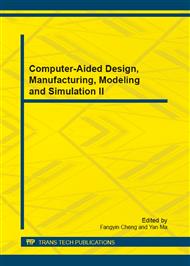[1]
Benson E R, Reid J F, Zhang Q. (2001). Machine Vision Based Steering System for Agricultural Combines. 2001 ASAE Annual International Meeting. No. 01-1159.
DOI: 10.13031/2013.3446
Google Scholar
[2]
Han S, Zhang Q, Ni B, et al. (2004). A guidance directrix approach to vision-based vehicle guidance systems. Computers and electronics in Agriculture 43: 179-195.
DOI: 10.1016/j.compag.2004.01.007
Google Scholar
[3]
Leemans V, Destain M F. (2006). Application of the Hough Transform for Seed Row Localisation using Machine Vision. Biosystems Engineering, 94 (3): 325-336.
DOI: 10.1016/j.biosystemseng.2006.03.014
Google Scholar
[4]
Leemans V, Destain M F. (2007). A computer-vision based precision seed drill guidance assistance. Computers and Electronics in Agriculture, 59: 1-12.
DOI: 10.1016/j.compag.2007.04.003
Google Scholar
[5]
Watanabe K, Chen B, Tojo S, et al. (1997). Study on the computer–eye of rice transplant robot (Part 1). Japanese Society of Agric. Machinery 59(2): 49–55.
Google Scholar
[6]
Chen B, Watanabe K, Tojo S, et al. (1997). Study on the computer–eye of rice transplant robot (Part 2). Japanese Society of Agric. Machinery 59(3): 23–28.
Google Scholar
[7]
Chen B, Tojo S, Watanabe K, et al. (1998). Study on the computer–eye of rice transplant robot (Part 3). Japanese Society of Agric. Machinery 60(5): 13–22.
Google Scholar
[8]
Chen B, Tojo S, Watanabe K, et al. (1999). Study on the computer–eye of rice transplant robot (Part 4). Japanese Society of Agric. Machinery 61(3): 57–64.
Google Scholar
[9]
Chen B, Tojo S, Watanabe K, et al. (1999). Detection of rice seedling in the image of paddy field. Japanese Society of Agric. Machinery 61(5): 57–63.
Google Scholar
[10]
Chen B, Tojo S, Watanabe K. (2003). Machine Vision Based Algorithmic Guiding System for Automatic Rice Transplanters. Applied Engineering in Agriculture, 19(1): 91-97.
DOI: 10.13031/2013.12726
Google Scholar
[11]
Chen B, Tojo S, Watanabe K. (2003). Machine Vision for a Micro Weeding Robot in a Paddy Field. Biosystems Engineering, 85(4): 393-404.
DOI: 10.1016/s1537-5110(03)00078-3
Google Scholar
[12]
Chen B, Tojo S, Watanabe K. (2002). Detection Algorithm for Traveling Routes in Paddy Fields for Automated Managing Machines. Transactions of the ASAE, 45(1): 239–246.
DOI: 10.13031/2013.7862
Google Scholar
[13]
Zhao Y, Chen B, Wang S, et al. 2006. Fast Detection of Furrows Based on Machine Vision on Autonomous Mobile Robot. Trans. Chinese Soc. Agric. Machinery, 37(4): 81-86. (in Chinese).
Google Scholar
[14]
Zhang L, Wang S, Chen B, et al. 2007. Crop-edge Detection based on Machine Vision. New Zealand Journal of Agricultural Research, 50(5): 1367-1374.
Google Scholar
[15]
Acknowledgements: This research was supported by the National Natural Science Foundation of China under Grant No. 31071329.
Google Scholar


